Choosing your method
Learning guitar takes time and a lot of dedication. Enthusiasm can fluctuate especially when you arrive at a plateau and feel you are not improving. Guitar lessons can be expensive but on occasions help you develop the next set of skills you were looking for. Another approach could be to implement guitar lesson software, you can get all of the benefits of professional guitar lessons with less of a price tag.
There are a number of different software options available but which one gives you the best value for money, suits your style and teaches what you want to know?
Serious or Fun
Guitar education software products can range from serious learning to learning through a more gaming approach. Teaching hit songs in a dynamic interactive environment may have a place in the learning process but may lack some of the core fundamentals of guitar and music theory than a thorough serious learning course. We’ve tried to sort through some of the main contenders in these categories and highlight what their main features are. RockSmith is not included in this article as it received a review earlier but is very much one of the main contenders.
Learn Guitar with Apps & Gaming Software
Coach Guitar
Overview

CoachGuitar shows you how to play popular songs on acoustic guitar with videos and animated fretboard. No music theory, no tablature, no guitar chords, you can learn to play guitar following a simple video tutorial system and color coded fingering chart. Whilst this app is free the songs taught will cost $3.00 each.
Features
Animated colored fretboard.
HD Videos.
Left or Right handed.
Step by step lessons.
Complete version of songs.
Backing track with voice.
Slowmotion / Loop Player.
Tablatures.
Free lessons included.
System Requirements
iPhone, iPad and iPod Touch
Approx Price: Free to install –
purchase songs at $3.00 / £2.00 / 20kr
coachguitar.com
Guitar Apprentice
Overview

Guitar Apprentice enables a user to play a “real” guitar along with an onscreen chart that updates in real-time, it’s format is very similar to and obviously influenced by video games like Guitar Hero.
The Gisbson website feature a number of Guitar Apprentice videos – where you can get the idea of what it is all about.
gibson.com
Features
Each song has 15 levels, beginning simply and increasing in difficulty with the increase in level. At the final level, a player is playing each chord contained in the song.
Using this software will cover guitar basics, tuning your guitar, how to use a pick
and other playing essentials.
Further skills taught include;
How to get the right tone for a song
Using the right effects and pedals
Alternate tunings
Slides and bends
Hammer-ons, pull-offs, and tapping
Palm mutes and using the Whammy bar
System Requirements
Broadband Internet
1.5 GHz processor or bigger
1 GB RAM or more
Available for PC, Mac, and mobile devices like the IPod, ITouch, and IPad.
Approx Price:
Purchase songs at $9.99 / £6.15 / 65kr
guitarapprentice.com
Rock Band
Overview
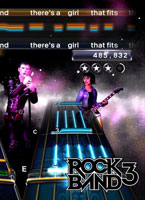
The series built on a strong foundation of local 4-player guitar, bass, drum, and vocal action, letting players live out their rock fantasies. The Rock Band franchise has gone on to sell over 18 million units worldwide and over 130 million individual song downloads, adding new fans and features along the way, including real-life pro instruments, a collaboration with The Beatles, a devoted UGC community for Rock Band Network, and a music library totaling over 4,000 songs.
Features
Designed exclusively for the Rock Band 3 Pro mode, the Squier by Fender Stratocaster guitar and controller allows players to play the actual notes and chords of their favorite songs. Compatible with PS3, Xbox 360 and Wii For wide-ranging use. (Requires Rock Band 3 MIDI PRO-Adapter – Sold Separately)
Agathis wood body with polyester finish, 22-fret maple neck with polymer fingerboard and position-sensing electronics. Enclosed tuners. Custom bridge pickup. Custom truss rod. 1/4″ output jack.
Standard 5-pin MIDI output jack, compatible with MIDI recording software.
System Requirements
Xbox or PlayStation
Midi adapter
The Guitar: Fender Squier plus the required MIDI adapter – over $300 / £185 / 1955kr
Approx Price: Purchase DVD’s for $15.00 / £9.20 / 98kr…
harmonixmusic.com
Riff Station
Overview
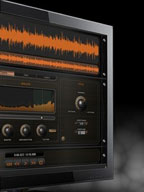
The ultimate practice app for guitarists and musicians, load your favorite songs and unlock the fundamental structure of the song isolate parts and play along. Riffstation is what happens when software developers who play guitar decide to build the ultimate guitar app. Utilizing audio DSP to bring you the most awesome guitar app available today. It’s easy to use and there are some interesting possibilities with this software.
Features
Get Guitar Chords For Any Song.
Chord Diagrams Synced With Your Music.
Change Key and Practice at Your Own Speed.
Practice Songs in Any Key.
Loop Riffs With Perfect Timing.
Transcribe Guitar Parts Easily.
Isolate the Guitar and Learn From the Masters.
Mute the Guitar and Play With Your Favorite Bands.
System Requirements
Windows XP & Vista, Windows 7 & 8
Mac OSX 10.6 and Higher – 64 Bit only
Approx Price: $54.00 / £33 / 350kr
riffstation.com
Serious Learning Software
Guitar Pro 6
Overview
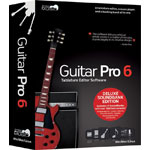
Guitar Pro is a musical software program offering all of the functionalism that all guitarists need.An innovative learning tool created by Arobas Music, is just one example of the many products out there designed to help people progress with their music, without the help of a traditional music school or teacher.
Features
Edit, visualize, and share your scores.
Learn to play or improve your technique.
Accompany yourself by creating the instrumental tracks of your choice.
Enjoy a series of essential tools: scale-validating tool, tuner, metronome, guitar fretboard.
System Requirements
Administrator’s rights for installation, Internet connection for activation
Intel Pentium 4 type processor
1 GB RAM
Sound card – DVD-ROM drive
256 MB free HD space
Screen resolution 1024 x 768
Approx Price: $80 / £50 / 530kr
guitar-pro.com
Guitar Method
Overview
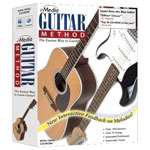
Produced by eMedia, Guitar Method is one of the more highly rated guitar software education options. It includes over 70 songs and 165 lessons featuring Kevin Garry Ph.D. as the instructor.This program comes with a large amount of tools such as a digital recorder and an electronic chord dictionary that can aid the learning curve more effectively. From beginner to progressive guitarist this package has something to offer from it’s extensive amount of lessons it can teach new techniques and chord combinations.
Features
Fully scalable lesson screens
70+ songs covering rock, blues, classical, country and folk genres
Music notation display options
More than 50 full motion videos with a full-screen viewing option
Interactive feedback for melodies
Animated fretboard displays fingering positions as the music plays
Variable-speed MIDI slows down the audio to any tempo
165 Step-by-Step Lessons
Automatic tuner allows you to play into your computer’s microphone and immediately get feedback to see if you’re too high or too low.
Chord dictionary with fingering charts and recorded sounds for over 250 chords.
Digital metronome allows you to set your own tempo and work on your picking speed, rhythm and timing.
Digital recorder allows you to compare your recordings with the instructor’s version, fine tune your skills and store musical ideas.
System Requirements
Sound card
VGA+ display
16 MB of free RAM
Approx Price: $50 / £30 / 310kr
emediamusic.com
Guitar Coach Deluxe
Overview
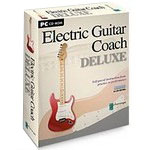
Guitar Coach Deluxe incorporates features such as an animated fretboard and recording tools, it includes a Chord Miner Professional that catalogues over 7000 chords and 41 chord types in every key. You can also build your own chord progressions, download chord sets and print arrangements. Guitar Coach contains 6 different modules it is possible to download each module individually or purchase the whole collection by mail order.No left hand facility, PC only.
Features
6 CD-ROMs containing lots of content to help you learn.
Each lesson covers a different aspect of guitar playing.
Full screen videos to help you learn new songs.
Download lessons individually ($12.50) or purchase the whole collection ($50.00)
Start from the basics of strumming techniques and chord fingerings.
40+ interactive guitar lessons.
30+ professional instructional videos with full-screen & slow-motion.
Practice tools, including variable-speed backing tracks & repetition loops.
Animated, variable-speed fretboard and strum hand to check fingering and accuracy.
Audio accompaniment to build ensemble performance skills.
Practice loops to help you perfect difficult passages.
Recording capability so that you can hear yourself playing with the backing tracks and track progress.
60+ full-screen practice videos with adjustable speed.
7000+ chords with multiple voicings of 41 chord types in every key.
System Requirements
PC only
8x CD-ROM drive
120MB of hard drive space
64MB of RAM
16 bit sound blaster compatible sound card
Internet connection preferred for product activation
Approx Price: $50 / £30 / 310kr
musiccoach.com
Teach Yourself to Play Guitar
Overview
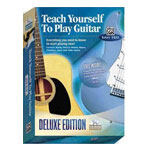
This guitar lesson software is based on the bestselling book, Alfred’s Teach Yourself to Play Guitar and teaches both acoustic and electric guitar lessons with interactive video clips. Although this program teaches all of the basics such as reading music notation and tablature, chords and scales it does not include rhythm lessons or have the ability to run repetitive loops.This software excels in the area of visual instruction where the combination of an animated fretboard and full motion video gives visual learners everything they need to learn to play the guitar.
Features
336-page Essential Dictionary of Music.
Over 60 songs covering blues, country, folk, jazz & heavy metal.
Learn to read standard music notation and TAB.
Perform songs in a variety of styles, and play chords, scales and cool licks on either acoustic or electric guitar.
Exercises to reinforce your technique as you follow along with music right on your screen.
Interactive song player lets you change tempos, adjust audio levels, and record your performance.
Videos of an instructor teaching and clearly demonstrating lessons.
Bonus games reinforce concepts taught in the method.
Customizable ear training program gives you the tools to play any song you hear.
Interactive guitar tuner keeps you in perfect tune.
System Requirements
64 MB RAM
640 x 480, 16-bit color display
8x CD-ROM drive
Approx Price: $32 / £21 / 210kr
guitarcenter.com
Gibson Learn and Master Guitar
Overview
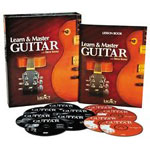
This set of 20 DVDs, 5 CDs and a 100+ page book sets out a comprehensive learning guide. The set of 20 DVDs which contain the video lessons that as you follow you will build up a complete and well rounded knowledge of playing guitar. The lessons cover everything from the basics of guitar maintenance through to the important steps of learning to play from both tablature and music notation, to advanced technique and developing your own unique playing style.
Features
20 professionally produced DVDs
Lessons divided into 20 sessions covering a huge range of playing styles, techniques and theory.
5 Jam Along CDs
Advanced training in all popular playing styles
100+ page lesson book
Free student support site.
System Requirements
64 MB RAM
640 x 480, 16-bit color display
8x CD-ROM drive
Approx Price: $249 / £150 / 1600kr
learnandmaster.com










